Portable Voltage Regulator: Principle, Design, Application
Date:2025-05-14 Click:838
With modern electronic devices ubiquitous today, portable voltage regulators have become critical components to ensure the stable operation of various electronic systems. From home appliances to mobile power systems, these delicate circuit components ensure that devices receive a stable and reliable power supply by precisely controlling voltage levels.
This article will comprehensively explore the technical principles, design considerations, and practical application scenarios of portable voltage regulators, with a special focus on usage requirements, power management strategies, operating characteristics analysis, and typical wiring diagram examples in home environments. We will also deeply analyze the special role of voltage-dependent resistors (VDRs) in voltage stabilization circuits, providing readers with a complete knowledge system from theoretical foundations to practical skills. Whether you are an electronics enthusiast, a professional technician, or an ordinary user, you can find valuable information about portable voltage regulators in this article to help you better understand, select, and use these important electronic components.
Portable Voltage Regulator Basics
Core Working Mechanism
The core function of a portable voltage regulator is to convert a fluctuating input voltage into a stable, accurate output voltage, regardless of changes in input voltage or load conditions. This process relies on a negative feedback control mechanism, where the system continuously monitors the output voltage and compares it to a reference voltage, compensating for any deviations by adjusting the operating state of internal components. Modern portable designs emphasize balancing high efficiency with compact size, making these devices widely used in space-constrained mobile scenarios.
Depending on the voltage regulation principle, these devices are mainly divided into two types: linear regulation and switching regulation. Linear regulators consume excess voltage through impedance changes of variable resistance elements (such as transistors) while switching regulators use fast switching methods to achieve voltage conversion with inductive energy storage. Each method has its unique performance characteristics and applicable scenarios, and understanding these differences is critical to design optimization.
Key Performance Parameters Analysis
When selecting a portable voltage regulator, engineers need to weigh multiple key parameter indicators. The input voltage range determines the power fluctuation amplitude that the regulator can handle. Typical portable designs must cover a wide range of inputs from 3.5V to 36V to adapt to various battery-powered scenarios. The output voltage accuracy directly affects the operating stability of the load device. High-quality regulators can achieve an accuracy level of ±2%.
Quiescent current (IQ) is a parameter of particular concern for battery-powered devices. It represents the regulator's power consumption when it is unloaded. Modern low-power designs can control it to around 2μA, significantly extending the standby time of portable devices. The voltage dropout (Vdropout) indicator is equally important. It defines the minimum difference between the input and output voltages, which directly affects the utilization of battery energy. An excellent design only requires a 300mV voltage drop under a 100mA load. Other parameters such as temperature coefficient, load regulation, and linear regulation jointly determine the reliable performance of the regulator under various environmental conditions.
Home application scenarios and power management
Home electronic equipment protection solutions
In the home environment, portable voltage regulators play the role of "power guards". Sensitive electronic devices such as routers, computers, and TVs require a clean and stable power supply. Voltage fluctuations may cause data errors, performance degradation, and even hardware damage. By configuring a proper voltage stabilization circuit, surges, drops, and noise interference in the power grid can be effectively filtered out.
Of particular concern is the home lighting system. The LED driver is extremely sensitive to the input voltage. An unstable power supply can cause brightness flickering, color temperature deviation, or shortened life. The use of a portable regulator with fast response characteristics can maintain a constant LED drive voltage when the power grid fluctuates to ensure lighting quality. For home appliances containing precision electronic components such as microwave ovens and ovens, the voltage stabilization circuit can also prevent control logic errors and improve safety.
Power distribution optimization strategy
The core challenge of home power management lies in dynamic load balancing. The start and stop of different electrical devices will cause instantaneous fluctuations in the power grid. Portable voltage regulators deal with this challenge through two mechanisms: one is to cope with peak demand through sufficient output current margin (usually 1.5 times the maximum load); the other is to use energy storage elements (such as supercapacitors) to temporarily make up for the energy gap.
In terms of energy efficiency optimization, modern designs use a multi-stage voltage regulation architecture. The front end uses a high-efficiency switching regulator for coarse adjustment, and the back end is fine-tuned with a low-noise linear regulator, which not only ensures overall efficiency but also obtains pure output. Power budget analysis shows that this hybrid architecture can save 15-20% energy compared to traditional solutions in typical home applications, which is of great significance for long-term equipment.
Operating Characteristics and Circuit Design
Dynamic Response Analysis
The transient response capability of a portable voltage regulator directly determines its performance under dynamic loads. When the load current changes suddenly, the regulator's control loop needs to adjust quickly to minimize the output voltage deviation.
The realization of this performance depends on the coordinated design of multiple factors: the gain-bandwidth product of the error amplifier determines the loop response speed; the equivalent series resistance of the output capacitor affects the high-frequency compensation; and the conversion rate of the power switch or the pass tube limits the theoretical limit. Modern portable designs generally use adaptive frequency compensation technology, which can automatically optimize the loop characteristics according to the load conditions and maintain stability over a wide operating range.
Thermal Management and Reliability
The heat generated during power conversion is the main challenge facing portable regulators. Thermal resistance model analysis shows that the thermal resistance from junction to ambient determines the operating temperature of the device, and this parameter is closely related to PCB layout and heat dissipation design.
To improve reliability, advanced designs use multiple thermal protection measures: temperature sensors monitor chip status in real-time; overtemperature warnings reduce load current in advance; thermal shutdown completely cuts off the output at the critical temperature. In terms of layout optimization, increasing the copper foil area, and using thermal via arrays and planes within multilayer boards are all effective means of enhancing heat dissipation. Thermal simulation data shows that a reasonable layout design can reduce thermal resistance by 30-50%, significantly improving long-term operating reliability.
Wiring Diagram Design and Implementation
Typical Circuit Configuration Example
The basic wiring architecture of a portable voltage regulator includes three parts: input filtering, voltage regulation core, and output conditioning. The voltage regulation core circuit varies according to the type: linear regulators only need to be configured with appropriate bypass capacitors; while switching regulators require inductors, freewheeling diodes, and feedback networks.
Voltage Dependent Resistor (VDR) Application
Voltage-dependent resistors (also known as varistors) provide transient protection in voltage regulation circuits. Their unique nonlinear characteristics make them present high impedance (megaohm level) under normal voltage, and quickly turn to low impedance when overvoltage occurs, shunting dangerous energy. In wiring design, VDRs are usually connected in parallel at the input or across sensitive components to absorb high voltage pulses generated by transient events such as lightning strikes and electrostatic discharges.
In terms of parameter selection, the clamping voltage of the VDR should be 20-30% higher than the maximum operating voltage of the circuit to ensure that it does not affect normal operation; and the current capacity needs to be determined according to the expected threat size, and a typical home application can choose a 100-1000A level. During layout, the VDR should be placed as close as possible to the protected device, and the lead length should be controlled within 3 cm to reduce the impact of parasitic inductance on the response speed. Test data shows that a properly configured VDR can limit transient overvoltage to a safe range and protect subsequent regulators from damage.
Conclusion and comprehensive recommendations
Portable voltage regulator technology has developed into a complete system covering multiple topologies and adapting to a wide range of application scenarios. From the analysis in this article, it can be seen that excellent voltage regulation design requires a delicate balance between electrical performance, thermal management, volume constraints and cost factors. Home users should focus on the matching degree of the regulator's input voltage range with local grid conditions, and the compatibility of output characteristics with load devices; in terms of power design, it is recommended to retain at least 30% margin to cope with load fluctuations and component aging; working stability can be improved by optimizing heat dissipation, suppressing ripples and strengthening protection.
The most effective solution in practical applications is often a hybrid architecture - the switching regulator handles the wide range of voltage conversion, the linear regulator provides clean output, and the protection components such as VDR defend against abnormal conditions. This combination can meet the requirements of portable devices for efficiency and miniaturization, while ensuring reliable performance under various working conditions.




